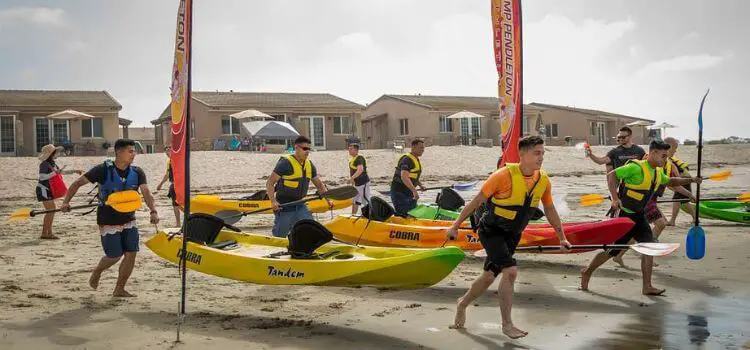As an Amazon Associates, I earn from quality purchases.
The concept of a tandem kayak is simple: a kayak built for two. It provides an opportunity for couples, friends, or family members to share the thrill of paddling together. However, many individuals wonder if one person can handle a tandem kayak on their own. In this article, we will delve into the world of solo tandem kayaking and address the question, “Can one person use a tandem kayak?”
The answer is yes! With a few adjustments in technique and some handy tips, you can embark on your kayaking journey alone, without missing out on the thrill and tranquility.
So, if you’ve ever dreamt of exploring the waterways in a tandem kayak all by yourself, don’t fret! Get ready to conquer the waters and discover the joy of navigating a tandem kayak solo. Stay tuned for my article. I’ll unravel the mystery and excitement of solo tandem kayaking. Happy paddling!
Understanding Tandem Kayaks

Tandem kayaks are specially designed kayaks that accommodate two paddlers. They typically have a longer length and wider beam than solo kayaks. It allows for increased stability and carrying capacity. Tandem kayaks often have two cockpits. Each one is equipped with its own set of footrests and paddle holders. While these kayaks are primarily intended for two-person use, they can be adapted for solo paddling.
Single Kayak vs Tandem Kayak: Key Differences
I have outlined the key differences between single kayaks and tandem kayaks in the table below.
Aspect | Single Kayak | Tandem Kayak |
Seating Capacity | Designed for one person | Designed for two people |
Size | Typically smaller and narrower | Larger and wider |
Weight | Lighter weight for easier maneuverability | Heavier due to larger size and capacity |
Maneuverability | Highly maneuverable with quick turns and agility | Less maneuverable, wider turning radius |
Speed | Faster speed due to smaller size and single paddler | Slower speed due to larger size and potential weight imbalance |
Solo Paddling | Designed for solo paddling | Can be paddled solo, but designed for tandem paddling |
Communication | No need for coordination with another paddler | Requires coordination and communication between two paddlers |
Storage Space | Limited storage capacity | More storage space available for gear and equipment |
Social Aspect | Suitable for individual solitude and personal exploration | Allows for shared experiences and teamwork with a partner |
Cost | Generally less expensive than tandem kayaks | Tandem kayaks can be more costly due to larger size and features |
Can One Person Handle a Tandem Kayak?
Tandem kayaks are designed for two paddlers. But it is possible for one person to handle a tandem kayak solo. Understanding weight distribution, adapting maneuvering techniques, and adjusting paddling techniques are key to successfully navigating a tandem kayak alone. With practice and safety precautions, solo paddlers can enjoy the benefits of tandem kayaks on their own.
Weight Distribution and Balance
To handle a tandem kayak alone, it’s important to manage weight distribution and maintain balance. Positioning yourself near the kayak’s center of gravity helps maintain stability and maneuverability.
Maneuvering Techniques
Sitting in the rear seating position and using techniques like paddling on the opposite side for turns can help solo paddlers maneuver a tandem kayak effectively.
Paddling Techniques
Adjusting paddling techniques, such as long strokes and engaging core muscles, optimizes efficiency and control. Experimenting with different paddle strokes, like the sweep stroke or draw stroke, aids navigation.
Safety Considerations
Ensure safety by wearing a personal flotation device (PFD). Inform someone about your plans and check weather conditions. Start with calm waters, and paddle within your skill level.
By applying these techniques and safety precautions, one person can successfully handle a tandem kayak solo and enjoy the benefits it offers.
Benefits of Using a Tandem Kayak Alone

Using a tandem kayak alone offers several advantages. Firstly, tandem kayaks are generally more spacious and offer greater storage capacity than solo kayaks. This can be particularly useful for extended trips or when carrying additional gear or supplies. Additionally, the larger size and increased stability of tandem kayaks make them suitable for paddling in various water conditions, including calm lakes, rivers, and even open waters.
Freedom and Flexibility
One of the significant benefits of using a tandem kayak alone is the freedom and flexibility it provides. When paddling solo, you have complete control over your kayak’s direction and speed. You can explore various water bodies at your own pace and choose the destinations that interest you the most. This freedom allows you to create your own adventure and tailor it to your preferences.
Enhanced Maneuverability
Solo tandem kayaking offers enhanced maneuverability compared to larger single-person kayaks. Tandem kayaks are typically longer and wider, which provides better stability and control.
As a solo paddler, you can easily maneuver the kayak through narrow passages. You can navigate around obstacles, and explore intricate waterways with ease. The improved maneuverability adds to the thrill and excitement of the kayaking experience.
Physical Fitness and Health Benefits
Engaging in solo tandem kayaking is an excellent way to improve physical fitness and enjoy numerous health benefits. Paddling a kayak requires the use of various muscle groups, including the core, arms, and shoulders.
The repetitive motion of paddling helps build strength, endurance, and cardiovascular fitness. Additionally, kayaking is a low-impact activity. It puts minimal stress on joints, making it suitable for people of different fitness levels.
Skill Development and Self-Confidence
Using a tandem kayak alone allows you to develop and refine your kayaking skills. As you paddle solo, you become more attuned to the kayak’s movement and learn to control it effectively.
You’ll gain a better understanding of water conditions. It will improve your navigation skills and increases confidence in your abilities as a kayaker. This increased self-confidence can extend beyond kayaking and positively impact other areas of your life.
Immersion in Nature
Solo tandem kayaking provides a unique opportunity to immerse yourself in nature and appreciate the beauty of your surroundings. You can paddle through serene lakes, meandering rivers, or along breathtaking coastlines, all while being completely connected to the natural environment.
The tranquility and solitude offered by solo kayaking allow for a deeper connection with nature. It provides a sense of peace and rejuvenation.
Personal Reflection and Meditation
Kayaking alone offers a chance for personal reflection and meditation. As you glide through the water, you can disconnect from the distractions of daily life and focus on your thoughts and emotions.
The rhythmic motion of paddling combined with the sounds of nature create a calming atmosphere, promoting mindfulness and relaxation. This meditative aspect of solo tandem kayaking can help reduce stress, enhance mental clarity, and foster personal growth.
Cost Efficiency
Opting for solo tandem kayaking can be cost-effective compared to purchasing and maintaining multiple single-person kayaks. Tandem kayaks are designed to accommodate two people, so using one alone allows you to save money on equipment.
Additionally, it diminishes the requirement for extra storage capacity. It is a practical choice for individuals who want to enjoy kayaking without the added expenses.
Challenges of Paddling a Tandem Kayak Alone
While solo paddling in a tandem kayak offers certain benefits, it also presents some challenges. One of the main difficulties is the weight distribution. Tandem kayaks are designed to be balanced with two people. So a single paddler may find it harder to control the kayak’s movements. Maneuverability can be another challenge. The longer length of tandem kayaks requires more effort to turn or navigate through tight spaces.
The Weight Factor
One of the primary challenges of paddling a tandem kayak alone is dealing with weight distribution. Tandem kayaks are typically larger and heavier than single-person kayaks. They are more difficult to handle when paddling solo.
The weight imbalance can cause the kayak to feel unstable and affect its maneuverability. It requires paddlers to exert more effort to maintain control and keep the kayak on course.
Balancing and Maneuvering
Solo paddlers face challenges in balancing and maneuvering a tandem kayak effectively. With the absence of a partner’s weight and movement, it becomes crucial to maintain stability on your own.
The wider design of tandem kayaks can make it harder to navigate through narrow passages or make quick turns. Paddlers need to develop a strong sense of balance and practice proper techniques to overcome these challenges.
Communication and Coordination
When paddling alone in a tandem kayak, communication, and coordination become more challenging. Tandem kayaks are designed for two paddlers to work together, coordinating their strokes and movements.
Without a partner, it becomes necessary to adjust your paddling technique to maintain control and efficiency. Effective communication with other kayakers or boaters on the water is also crucial for safety reasons.
Increased Physical Exertion
Paddling a tandem kayak alone requires more physical exertion compared to paddling with a partner. The larger size and weight of the kayak, combined with the absence of shared effort, can put additional strain on the solo paddler.
It requires increased strength and stamina to maintain a consistent pace and cover longer distances. Solo paddlers should be prepared for the physical demands and take regular breaks as needed.
Techniques for Solo Paddling in a Tandem Kayak

To paddle a tandem kayak solo, it is important to maintain balance and control. Here are some techniques to help you navigate the waters comfortably:
Positioning:
Sit in the center of the kayak to distribute your weight evenly. This will help maintain balance and prevent the kayak from tipping to one side.
Footrests:
Adjust the footrests in the front cockpit to a comfortable position that allows you to reach the foot pedals easily. This will provide stability and control over the kayak’s movement.
Paddling Techniques:
Utilize a combination of forward strokes, sweep strokes, and rudder adjustments to maneuver the kayak effectively. Practice different strokes to enhance your paddling skills and maintain a straight course.
Trim Adjustment:
Experiment with the trim of the kayak by shifting your weight slightly forward or backward. This will help optimize the kayak’s performance and responsiveness.
Where Should You Sit in a Tandem Kayak?
If you find yourself kayaking alone in a tandem kayak, you might be wondering where the best place to sit is for optimal control and balance. When paddling solo in a tandem kayak, it is generally recommended to sit in the back seat, also known as the stern seat. Here’s why:
Steering Control:
By sitting in the back seat, you have better control over steering and maneuvering the kayak. You can easily reach the kayak’s stern and use your paddle strokes to guide it in the desired direction.
Weight Distribution:
Placing your weight in the back seat helps to balance the kayak. Since there is no paddler in the front seat, having your weight towards the rear helps maintain stability. It prevents the kayak from tilting forward.
Improved Visibility:
Being in the back seat provides a clear view of the water ahead. It allows you to navigate obstacles and plan your route effectively.
Easier Access to Gear:
Sitting in the back seat allows you convenient access to any gear or equipment stored behind you. This makes it easier to reach essentials without disrupting your paddling rhythm.
Safety Considerations
Before embarking on solo tandem kayaking, it is crucial to prioritize safety. Here are some important safety considerations:
Personal Floatation Device (PFD):
Always wear a properly fitted PFD when kayaking to ensure your safety in case of an accident or capsize.
Communication:
Inform someone about your kayaking plans, including your intended route and estimated time of return. This will enable others to take appropriate action if necessary.
Weather Conditions:
Check the weather forecast before heading out. Avoid kayaking in adverse weather conditions such as high winds, storms, or foggy situations.
Self-Rescue Techniques:
Familiarize yourself with self-rescue techniques specific to tandem kayaks. Practice re-entering the kayak from the water to build confidence and preparedness.
Best Practices for Solo Tandem Kayaking
To make the most out of your solo tandem kayaking experience, consider the following best practices:
Skill Development:
Enhance your kayaking skills through training and practice. Take a solo kayaking course to learn specific techniques for paddling a tandem kayak alone.
Proper Gear:
Invest in high-quality gear designed for solo kayaking. This includes a paddle suitable for single-person use and any additional equipment required for your specific kayaking adventures.
Trip Planning:
Plan your kayaking trips thoughtfully, considering factors such as water conditions, distance, and the duration of your excursion. Research the area and be aware of any potential hazards or restrictions.
Enjoy the Journey:
Solo kayaking allows you to immerse yourself in the natural surroundings and enjoy the tranquility of the water. Take the opportunity to connect with nature and appreciate the solitude.
Equipment and Accessories for Solo Tandem Kayaking
To make your solo tandem kayaking experience more enjoyable, consider using the following equipment and accessories:
Paddle Float:
A paddle float can assist in re-entering the kayak after a capsize. It provides added stability and buoyancy.
Kayak Cart or Trolley:
A kayak cart or trolley can help transport the tandem kayak to and from the water, especially if you need to navigate across uneven terrain.
Deck Bag or Dry Bag:
Use a deck bag or dry bag to store your personal belongings securely and protect them from water splashes or potential capsizes.
Kayak Seat Cushion:
You can have a comfortable kayak seat cushion. It will alleviate any discomfort during longer paddling sessions.
Techniques for Maneuvering a Tandem Kayak Alone
Solo paddling in a tandem kayak requires specific techniques to ensure smooth maneuverability. Here are some techniques to follow:
Sweep Strokes:
Utilize sweep strokes on the side opposite your desired turning direction to effectively steer the tandem kayak.
Reverse Paddling:
Master the technique of paddling backward to enhance your ability to navigate tight spots or perform quick turns.
Bracing:
Learn and practice bracing techniques to maintain stability and prevent capsizing, especially when encountering waves or challenging water conditions.
Edging:
By slightly tilting the kayak to one side (edging), you can enhance its maneuverability and control.
Final Thoughts!
Tandem kayaks are primarily designed for two-person use. But, it is possible to paddle them alone with the right techniques and safety precautions. Solo tandem kayaking provides additional storage capacity, increased stability, and versatility for various water conditions.
By practicing proper paddling techniques and prioritizing safety, you can explore the joys of solo kayaking in a tandem kayak.
FAQs
Q: Do you need two people for a tandem kayak?
A: While tandem kayaks are designed for two people, they can be paddled by a single person as well. However, having two paddlers provides better balance and allows for shared paddling responsibilities.
Q: How do you carry a tandem kayak by yourself?
A: Carrying a tandem kayak alone can be challenging due to its size and weight. One common method is to lift the kayak onto your shoulder with the assistance of a kayak trolley. Or, by placing one end on your shoulder and supporting the other end with your hand.
Q: Is it better to do a single or tandem kayak?
A: The choice between a single kayak and a tandem kayak depends on personal preferences and the intended use. Single kayaks offer more independence and maneuverability. Tandem kayaks allow for shared experiences and teamwork. Consider factors such as paddling goals, desired social aspect, and the specific kayak’s features to determine which option suits you best.
Q: Do tandem kayaks tip easily?
A: Tandem kayaks have a wider hull. They provide better stability compared to narrower kayaks. However, they can still tip if not properly balanced or in rough water conditions. Proper weight distribution, maintaining a low center of gravity, and practicing good paddling techniques help minimize the risk of tipping.
Q: Who steers in a tandem kayak?
A: Both paddlers in a tandem kayak can contribute to steering and maneuvering. Typically, the paddler in the back seat (stern) has better control over steering. The paddler in the front seat (bow) sets the pace and helps with balance. Effective communication and coordination between the two paddlers are key to successfully steering a tandem kayak.
Q: Is solo tandem kayaking safe?
A: Solo tandem kayaking can be safe if you follow proper safety guidelines and precautions. It is important to wear a PFD, inform someone about your plans, and be mindful of weather conditions and your own skill level.

Leave a Reply